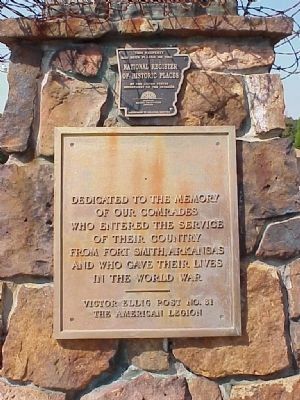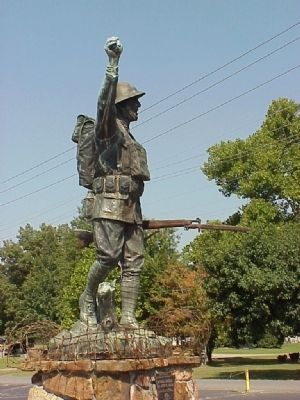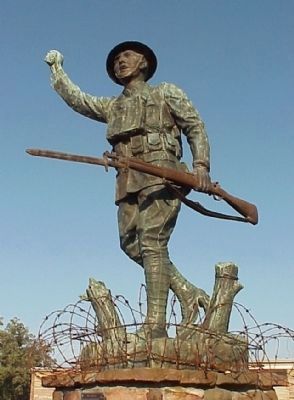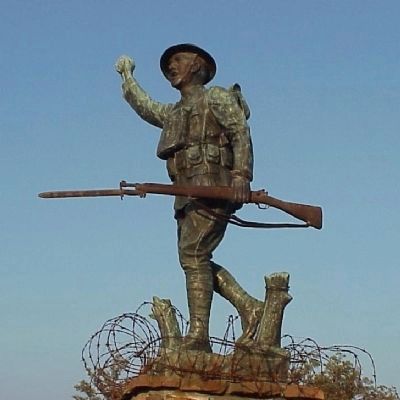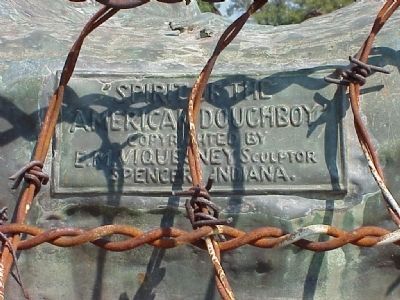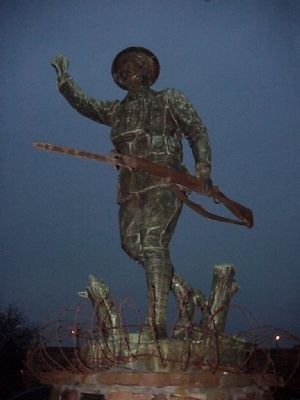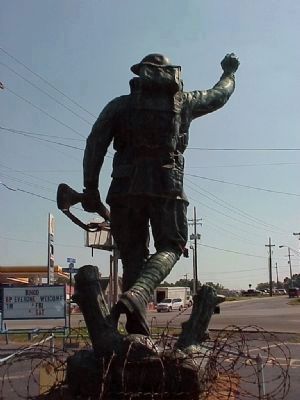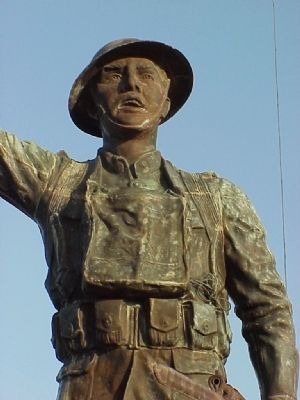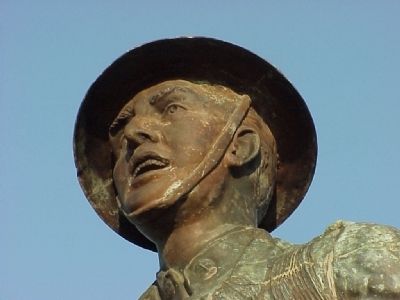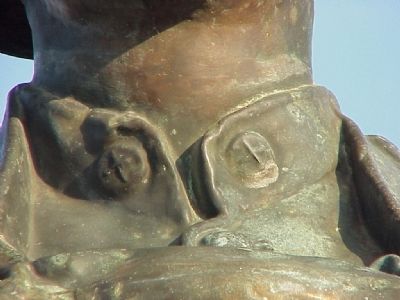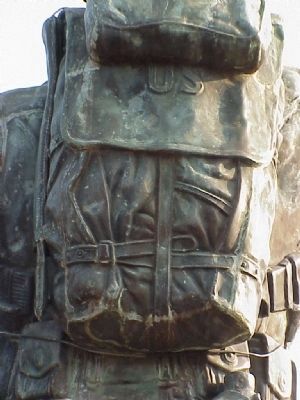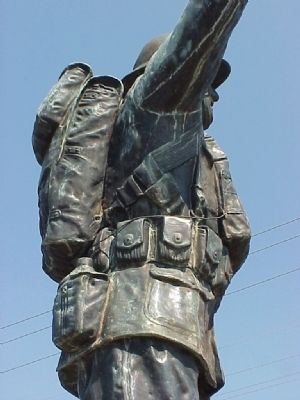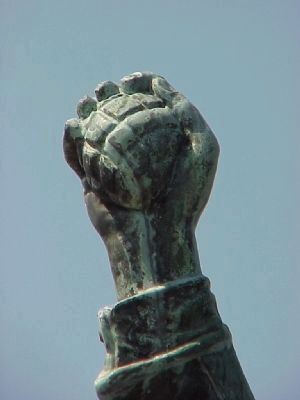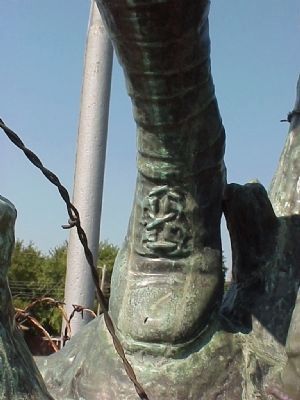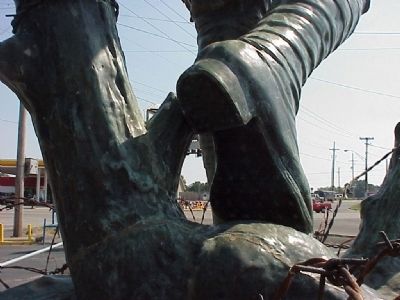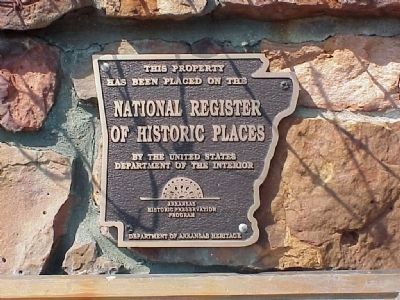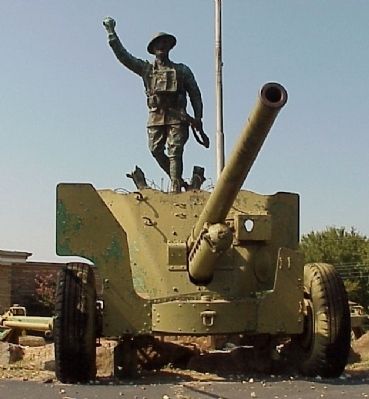Fort Smith in Sebastian County, Arkansas — The American South (West South Central)
“Spirit of the American Doughboy”
Fort Smith, Arkansas
Dedicated to the memory of our comrades who entered the service of their country from Fort Smith, Arkansas and who gave their lives in the World War.
Erected by Victor Ellig Post No. 31, The American Legion.
Topics and series. This historical marker is listed in this topic list: War, World I. In addition, it is included in the Spirit of the American Doughboy - E. M. Viquesney series list.
Location. 35° 25.396′ N, 94° 22.54′ W. Marker is in Fort Smith, Arkansas, in Sebastian County. Marker is at the intersection of Midland Blvd (U.S. 64) and N. 50th Street on Midland Blvd. Touch for map. Marker is at or near this postal address: 4901 Midland Blvd, Fort Smith AR 72904, United States of America. Touch for directions.
Other nearby markers. At least 8 other markers are within 2 miles of this marker, measured as the crow flies. Overlooking His Domain (approx. 1.2 miles away); Web of Enterprise (approx. 1.2 miles away); Van Buren Raid (approx. 1.3 miles away); Gone but not forgotten (approx. 1.3 miles away); CSI: Van Buren (approx. 1.3 miles away); Albert Pike School House (approx. 1.3 miles away); The Butterfield Stage Route (approx. 1.3 miles away); Crawford County Confederate Memorial (approx. 1.4 miles away).
More about this marker . The "Spirit of the American Doughboy" statue is located in the Ellig-Stoufer American Legion Post #31 parking lot. The statue is visible to hundreds of people daily who pass by in their vehicles. At night the statue is lit by floodlight.
Also see . . .
1. The Fort Smith Statue. The E.M. Visqueny Doughboy Database entry:
A picture of this Doughboy, on a pedestal at Lewis Tilles Park, was included in Viquesney promotional brochures. This link also includes pictures of this statue in its original location in Tilles Park. (Submitted on February 21, 2008, by Kevin W. of Stafford, Virginia.)
2. Spirit of the American Doughboy Statue at Fort Smith. Flickr website entry:
Pictures and text on this page are used with permission of the artist. (Submitted on February 21, 2008, by Kevin W. of Stafford, Virginia.)
Additional commentary.
1. General History of Viquesney’s Spirit of the American Doughboy Statues
The Spirit of the American Doughboy, sculpted by Ernest Moore Viquesney (August 5, 1876 – October 4,1946), was designed to honor the veterans and casualties of World War I. Mass produced during the 1920s and 1930s for communities throughout the United States, the statue’s design was the most popular of its kind; spawning a wave of collectible miniatures and related memorabilia as well as numerous copies by other artists. Nicknames for the statue are “The Doughboy” and Iron Mike.
Viquesney, who lived from 1876 to 1946, devoted two years to perfecting what was to become his trademark. During this time he interviewed scores of World War I veterans, studied hundreds of photographs, and used two soldiers as live models. The finished product, completed in 1920, was a statue described by the Helena World as “the only true representation of the real Doughboy and his indomitable spirit.” Viquesney’s Doughboy monument, which was named the official World War I National Memorial, became extremely popular and was erected by towns across America until the late 1930s.
There are three versions of the statue: This one is a pressed copper version, copyrighted in 1920 and produced by Friedley-Voshardt Company of Chicago, IL, from 1921 to 1933; a rare stone version, copyrighted in 1922 and existing in only three locations (Madison, GA, Madison, WV, and Parsons, KS); and a cast zinc version (often copper-plated) copyrighted in 1934.
The statue depicts a doughboy walking through shattered tree stumps strung with barbed wire, his rifle in his left hand and his right hand held high above his head, clutching a hand grenade. The aggressive design and affordability of the statue made it extremely popular, and more than 150 copies of it were created for municipal memorials across the nation. The Smithsonian American Art Museum currently lists 159 locations. Of that number, 134 currently existing originals have been independently authenticated, and several have been identified as copies by other artists. Viquesney’s actual brochures quoted a figure of over 300 by the late 1930s, claiming at least one in every state of the Union, but this is believed to be an inflated figure.
Installed in cemeteries, town squares, outside museums, parks, on courthouse lawns, and countless other places, the design is said to be the most-viewed example of outdoor statuary in the US (after the Statue of Liberty) although many people do not even realize they have seen it.
Two of the statues, both in Arkansas, are listed on the National Register of Historic Places - one in Helena and this one in Fort Smith. Note To Editor only visible by Contributor and editor
— Submitted February 20, 2008, by Kevin W. of Stafford, Virginia.
2. General History of the Fort Smith “Spirit of the American Doughboy”
The Victor Ellig American Legion Post #31 (named after the first soldier from Fort Smith, Arkansas to be killed in WWI) was always heavily involved with creating and promoting parks and playgrounds in Fort Smith. In 1928, the Commander Henry Armstrong was named permanent chairman of the city’s parks and playgrounds commission. A committee was formed then, “investigating the immediate needs of Lewis Tilles children’s park.”
It was at about this time that the post began a drive to install a World War I memorial at Tilles Park. That effort came near fruition in April of 1930, when the Arkansas Legionnaire announced that an "announcement has been made that with the city park board paying $500 of the $1,000 necessary, a lifesize bronze statue of a Doughboy will be erected at the entrance to the Lewis Tilles Children's park, Grand Avenue, as a memorial to the men who served in the World War." The statue had already been ordered, and dedication was planned that summer.
Appropriately, the dedication was scheduled for July 4, 1930. More than 2,000 people gathered at Tilles Park that evening for a ceremony that "including the unveiling and dedication of 'The Spirit of the American Doughboy,' the first night tennis match ever held in the city, and a band concert." Mr. and Mrs. O.C. Ellig, Victor Ellig's parents, and several Gold Star mothers were in attendance. Dr. W.R. Brooksher, who led the committee that since 1928 had worked to acquire a World War I memorial, presented the statue to Victor Ellig Post No. 31 Commander
John Coley, who in turn presented it to Henry Armstrong of the parks and playgrounds commission. Armstrong then formally presented the monument to Mayor Fagan Bourland. The statue was unveiled by "two little misses," Jo Ann Carroll and Nancy Mae Connor, and the ceremony ended with the singing of "America."
Fort Smith's Doughboy monument is not unique; it is part of a nationwide series of Doughboy sculptures designed by artist E. M. "Dick" Viquesney. Although the full number is uncertain, 136 Viquesney Doughboys in 35 different states have been identified as of 1991, and some experts consider it one of the most-seen pieces of outdoor statuary in the nation.
The Fort Smith monument remained in Tilles Park for half a century, but was warehoused by the city after frequent and substantial vandalism, including the destruction of the figure's rifle. After restoration by the talented artist Ralph Irwin of Van Buren, Arkansas, it was rededicated at its current location in front of the Ellig-Stouffer American Legion Post #31 (4901 Midland Boulevard) on Memorial Day, 1998.
— Submitted February 20, 2008, by Kevin W. of Stafford, Virginia.
3. “No Man’s Land”
No Man’s Land is an eerie sight
At early dawn in the pale gray light.
Never a house and never a hedge
In No Man’s Land from edge to edge,
And never a living soul walks there
To taste the fresh of the morning air;
Only some lumps of rotting clay,
That were friends or foemen yesterday.
What are the bounds of No Man’s Land?
You can see them clearly on either hand,
A mound of rag-bags gray in the sun,
Or a furrow of brown where the earthworks run
From the eastern hills to the western sea,
Through field or forest o’er river and lea;
No man may pass them, but aim you well
And Death rides across on the bullet or shell.
But No Man’s Land is a goblin sight
When patrols crawl over at dead o’ night;
Boche or British, Belgian or French,
You dice with death when you cross the trench.
When the "rapid," like fireflies in the dark,
Flits down the parapet spark by spark,
And you drop for cover to keep your head
With your face on the breast of the four months’ dead.
The man who ranges in No Man’s Land
Is dogged by the shadows on either hand
When the star-shell’s flare, as it bursts o’erhead,
Scares the gray rats that feed on the dead,
And the bursting bomb or the bayonet-snatch
May answer the click of your safety-catch,
For the lone patrol, with his life in his hand,
Is hunting for blood in No Man’s Land.
By Captain James H. Knight-Adkin
from the book A Treasury of War Poetry published in 1917, George Herbert Clarke, ed. (1873-1953)
— Submitted February 20, 2008, by Kevin W. of Stafford, Virginia.
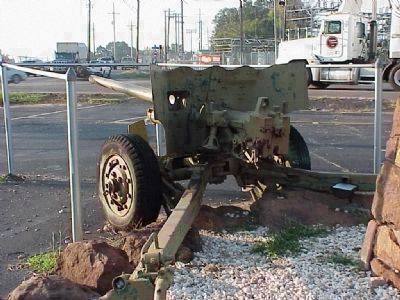
Photographed By Sunny Brook, December 1, 2007
18. World War II 57mm M1 anti-tank gun
The artillery piece in front of this marker is a World War II 57mm M1 anti-tank gun, which was actually an example of reverse Lend-Lease. In 1942, the US did not have an anti-tank gun that could destroy German tanks. The British provided the drawings and specifications for their 6-pounder [57mm] which was adapted to U.S. practices. By mid-1944 the M1 was the standard U.S. antitank gun, with over 15,000 produced. It went out of U.S. service shortly after the end of the war.
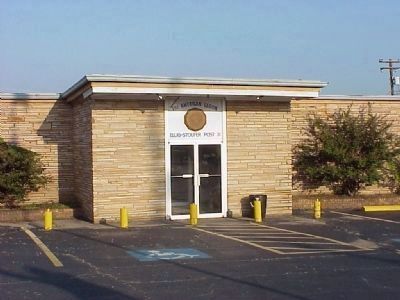
Photographed By Sunny Brook, December 1, 2007
19. Ellig-Stoufer American Legion Post #31
This American Legion post was named after Victor Ellig, the first Fort Smith soldier to die in World War I. He was shot through the heart by a German sniper while advancing on an enemy position on July 22, 1918.
The Arkansas Legionnaire called the Ellig post "a model organization" and "enthusiastic." For several years it was always among the leaders in the Legion's perennial state membership drives, being ranked as the state's largest at least twice, in 1923 and 1926.
This is not the original building of the post. The first building burned, and this one was built on the same site.
The Arkansas Legionnaire called the Ellig post "a model organization" and "enthusiastic." For several years it was always among the leaders in the Legion's perennial state membership drives, being ranked as the state's largest at least twice, in 1923 and 1926.
This is not the original building of the post. The first building burned, and this one was built on the same site.
Credits. This page was last revised on August 4, 2022. It was originally submitted on February 20, 2008, by Kevin W. of Stafford, Virginia. This page has been viewed 4,240 times since then and 46 times this year. It was the Marker of the Week May 26, 2013. Photos: 1, 2, 3, 4, 5, 6, 7, 8, 9, 10, 11, 12, 13, 14, 15. submitted on February 20, 2008, by Kevin W. of Stafford, Virginia. 16. submitted on February 21, 2008, by Kevin W. of Stafford, Virginia. 17, 18, 19. submitted on February 20, 2008, by Kevin W. of Stafford, Virginia.
